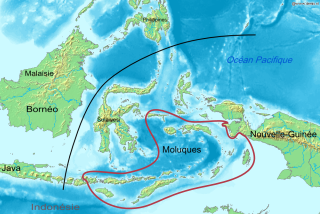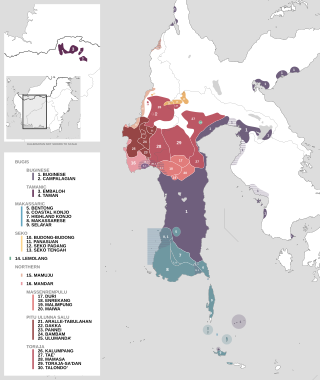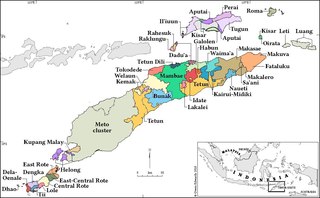Related Research Articles

The Papuan languages are the non-Austronesian languages spoken on the western Pacific island of New Guinea, as well as neighbouring islands in Indonesia, Solomon Islands, and East Timor. It is a strictly geographical grouping, and does not imply a genetic relationship.
Tukang Besi is an Austronesian language spoken in the Tukangbesi Islands in southeast Sulawesi in Indonesia by a quarter million speakers. A Tukang Besi pidgin is used in the area.
Wetarese is an Austronesian language of Wetar, an island in the south Maluku, Indonesia, and of the nearby island Liran.

The Central Malayo-Polynesian languages (CMP) are a proposed branch in the Malayo-Polynesian subgroup of the Austronesian language family. The languages are spoken in the Lesser Sunda and Maluku Islands of the Banda Sea, in an area corresponding closely to the Indonesian provinces of East Nusa Tenggara and Maluku and the nation of East Timor, but with the Bima language extending to the eastern half of Sumbawa Island in the province of West Nusa Tenggara and the Sula languages of the Sula archipelago in the southwest corner of the province of North Maluku. The principal islands in this region are Sumbawa, Sumba, Flores, Timor, Buru, and Seram. The numerically most important languages are Bima, Manggarai of western Flores, Uab Meto of West Timor, and Tetum, the national language of East Timor.

The South Halmahera–West New Guinea (SHWNG) languages are a branch of the Malayo-Polynesian languages, found in the islands and along the shores of the Halmahera Sea in the Indonesian province of North Maluku and of Cenderawasih Bay in the provinces of Papua and West Papua. There are 38 languages.
Tidore is a language of North Maluku, Indonesia, spoken by the Tidore people. The language is centered on the island of Tidore, but it is also spoken in some areas of the neighbouring Halmahera. Historically, it was the primary language of the Sultanate of Tidore, a major Moluccan Muslim state.
Sangir, also known as Sangihé, Sangi, Sangil, or Sangih, is an Austronesian language spoken on the islands linking northern Sulawesi, Indonesia, with Mindanao, Philippines by the Sangir people. It belongs to the Philippine group within the Austronesian language family.
Wolio is an Austronesian language spoken in and around Baubau on Buton Island, Southeast Sulawesi, Indonesia. It belongs to the Wotu–Wolio branch of the Celebic subgroup. Also known as Buton, it is a trade language and the former court language of the Sultan at Baubau. Today it is an official regional language; street signs are written in the Buri Wolio alphabet, based on the Arabic script.
The Muna–Buton languages are a group of languages spoken on the islands of Muna and Buton off the coast of South East Sulawesi province, Indonesia. They belong to the Celebic subgroup of the Austronesian family.

The Celebic languages are a subgroup of the Austronesian languages spoken on the Indonesian island of Sulawesi, formerly called Celebes. Almost all of the languages spoken in the provinces of Central Sulawesi and Southeast Sulawesi belong to the Celebic group. A few Celebic languages are located in South Sulawesi province. By number of languages, Celebic is the largest subgroup of Austronesian languages on Sulawesi.
The Kei–Tanimbar languages are a small group of Austronesian languages spoken on the Kei and Tanimbar islands in the southern Maluku Islands, and on the north side of the Bomberai Peninsula. The languages include:
Kei is an Austronesian language spoken in a small region of the Moluccas, a province of Indonesia.
Ternate is a language of northern Maluku, eastern Indonesia. It is spoken by the Ternate people, who inhabit the island of Ternate, as well as many other areas of the archipelago. It is the dominant indigenous language of North Maluku, historically important as a regional lingua franca. A North Halmahera language, it is unlike most languages of Indonesia which belong to the Austronesian language family.

The North Halmahera (NH) languages are a family of languages spoken in the northern and eastern parts of the island of Halmahera and some neighboring islands in Indonesia. The southwestern part of the island is occupied by the unrelated South Halmahera languages, which are a subgroup of Austronesian. They may be most closely related to the languages of the Bird's Head region of West Papua, but this is not well-established.
Selaru is an Austronesian language of Selaru and Yamdena, in the Maluku Islands of Indonesia. Linguistically it is not close to Seluwasan, its nearest relative.

Coastal Konjo is an Austronesian language of Sulawesi, Indonesia, which belongs to the Makassaric branch of the South Sulawesi subgroup. It is spoken along the coast in the southeastern corner of South Sulawesi in the regencies of Sinjai, Bulukumba and Bantaeng. It is closely related to, but distinct from Highland Konjo, which also belongs to the Makassaric languages.
Lenakel, or West Tanna, is a dialect chain spoken on the western coast of Tanna Island in Vanuatu.
Dobel, or Kobro’or, is one of the Aru languages, spoken by inhabitants of the Aru Islands Regency. It is close to Kola.
Tarangan is one of the Aru languages, spoken by inhabitants of the Aru Islands in eastern Indonesia. There are two varieties of Tarangan: East and West Tarangan. These varieties are divergent, perhaps no closer than they are to Manombai, also spoken in the Arus. West Tarangan is a trade language of the southern islands.

The Rote–Meto languages are a subgroup of the Austronesian language family spoken in the Lesser Sunda Islands. It includes Meto spoken on Timor and the languages of Rote Island.
References
- ↑ Fordata at Ethnologue (18th ed., 2015) (subscription required)
- ↑ Mills, Roger F. (1991). "Tanimbar-Kei: An Eastern Indonesian Subgroup". In Robert Blust (ed.). Currents in Pacific Linguistics: Papers on Austronesian Languages and Ethnolinguistics in Honour of George W. Grace. Canberra: Pacific Linguistics. pp. 241–263.
- ↑ Marshall, Craig (2000). "A Phonological Description of Fordata". In Grimes, C. E. (ed.). Spices from the East: Papers in Languages of Eastern Indonesia. PL-503. Canberra: Pacific Linguistics. pp. 181–235. doi: 10.15144/PL-503.181 .